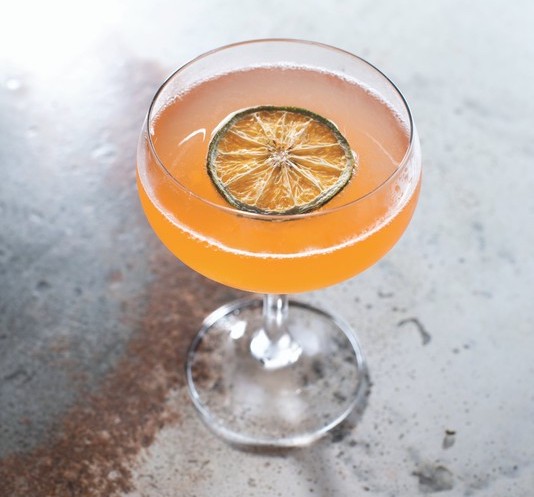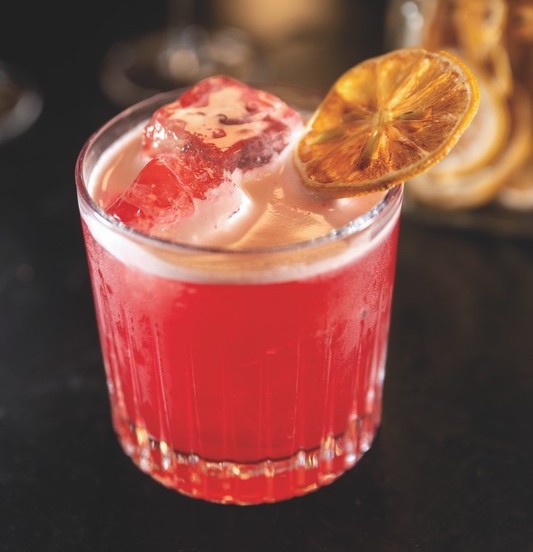
Diet fads may come and go, but healthful habits tend to always be on trend—and they became particularly relevant during the pandemic. “I believe that the last couple of years and the frailty of the unknown has made people much more aware and mindful of what they’re putting in their bodies,” says Leah Carricato, senior operations manager for Captivate Hospitality Group, which owns the Solstice restaurant concept in Newtown, Pennsylvania and Irvine, California. “Being more health-conscious is really an overarching cultural shift in thought process that has also extended to cocktails.”
Seth Corr, beverage director for Greens, a vegetarian restaurant in San Francisco, agrees, noting that while the early days of lockdown resulted in a lot of indulgence, this shifted over time. “There was a trend of drinking more early on in 2020, and once people realized the effects of drinking more frequently they adapted to creating cocktails that didn’t make them feel as bad the next day,” he says. “I do think this trend was coming about before the pandemic, and Covid-19 brought it to the forefront.”
But healthful drinking doesn’t have to be dull, as Michelle Morgan, owner of the vegetable-forward restaurant TLK in New York City, points out. “Hopefully more people are learning how easy it is to take the healthier options,” she says. “It’s possible to have fun in a healthier way with the right decisions, opting for ingredients that are good or better for your body without compromising flavor.”

Hold The Sugar
Perhaps the biggest trend in drinking over the last several years that also happens to be more healthful is the movement away from overly sweet and sugary drinks. “We’ve seen the overall consumer market becoming more health-conscious when it comes to cocktails with less sugar and cocktails that are naturally flavored, which is why we produce our own house-made syrups for our cocktails at Avli on The Park,” says Blake Leonette, bar manager at the Chicago restaurant. “We also like using natural ingredients, such as loose leaf hibiscus tea, to create powerful and naturally flavored cocktails that are still health-conscious. The natural sweetness of hibiscus tea is a wonderful replacement for high-sugar drinks—it creates a sweet, yet slightly earthy and cranberry taste perfect for crushable summer cocktails.” His Spill The Tea ($16) blends Tito’s vodka, Skinos Mastiha liqueur, chilled loose-leaf hibiscus tea, and lemon juice.
Polina Jourbina, beverage manager at The Mermaid Inn Oyster Bar in New York City, also notes that guests are frequently seeking drinks with little or no sugar added. “A classic Moscow Mule would usually be with ginger beer, but I prefer to make mine with ginger syrup,” she says. “Instead of almost a full serving of ginger beer, mine has less than an ounce of ginger syrup. The flavor isn’t skimmed, but the sugar and calories are—plus ginger has tons of benefits to the immune system.” Her Moscow Mule ($16) features Tito’s vodka, 1883 Maison Routin Ginger syrup, lime juice, club soda, and Angostura bitters. “Zero sugar and zero calorie sodas are becoming more frequently used in cocktails—it’s an easy alternative to keep the same flavor as a traditional soda mixer but without the sugar,” TLK’s Morgan says. “We use different flavors of Sanzo soda water to add bubbles and flavor without sugar or calories to make refreshing cocktails.” Created for TLK by consulting bartender Channing Centeno, the Passion Flower ($17) features Del Maguey Vida mezcal, Aperol aperitif, St-Germain liqueur, passion fruit purée, house-made ginger syrup, and Sanzo Mango sparkling water.

Captivate Hospitality Group’s Carricato points out that as cocktail culture has grown, people are more discerning about their cocktail choices. “Guests will now ask if their cocktail is made with fresh juice or syrups as a deciding factor and now tend to shy away from a lot of the pre-made mixers that were once commonly placed in every bar,” she says, noting that fresh fruits, vegetables, and spices are popular, as are sugar replacements like stevia and agave. “I love utilizing traditionally savory ingredients and highlighting them in a refreshing cocktail,” she adds. “One of my favorites I’ve made is a gin-based cocktail with celery. It’s bright, grassy, and herbaceous, while also having a refreshing quality.” The drink is called the Gin Cocktail 2 ($15 in Newtown, Pennsylvania; $16 in Irvine, California), comprising Ford’s gin, Chartreuse liqueur, house-made celery syrup, and lime juice. House-made syrups and other tinctures are a big part of Solstice’s beverage program. For the restaurant’s Irvine location, bar manager Dylan Dinsmore created a strawberry chili shrub of fresh strawberries, Fresno and serrano peppers, sugar, and apple cider vinegar, which is featured in his Tequila Cocktail 2.1 ($13) along with Altos Plata Tequila, Combier orange liqueur, lime juice, simple syrup, and saline, and also in his non-alcoholic Strawberry Chili Spritz ($8), in which its mixed with sparkling water.
Corr of Greens notes that the largest trend he’s seeing in more healthful drinking is the rise of cocktails with lower or no alcohol content. “I’ve noticed aperitifs becoming more popular, as well as the inverted cocktail style, where you have a high-quality low-abv or no-abv base ingredient,” he says. “My Inverted Martini is for those that want a healthier option that still has alcohol—I use a higher-end vermouth made with quality grapes and foraged botanicals for a fresher and brighter result that is better for you.” The drink ($14) blends Bordiga Extra Dry vermouth with Letherbee Vernal 2021 gin. His Pinot Noir & Hibiscus Spritzer ($14) is similarly low-abv, featuring Sirene Americano aperitif, Navarro Pinot Noir, lemon juice, and Sirene China Calisaia bitters.
At Dusek’s Tavern in Chicago, the Dusek’s Spritz ($11) mixes Zubrowka Bison Grass vodka, house-made blueberry and mint shrub, lemon juice, Gruet Blanc de Noirs sparkling wine, and sparkling water. “Our rotating Spritz is always lower in alcohol and employs seasonal fruit from our kitchen,” says Mark Phelan, beverage director for 16 On Center, the hospitality collective that owns Dusek’s Tavern. “For the warmer months we feature a blueberry and mint shrub with an apple cider vinegar base. Blueberries are rich in antioxidants and probiotic apple cider vinegar aids digestion, so this is as close to a healthy cocktail as one can get.”

Vitamin Boost
Chuckiy Bement, former beverage director at The Bristol in Chicago, notes that while people are indeed moving away from sugary cocktails, they’re still looking to be wowed by bartenders. “Consumers want something interesting, and cocktails that incorporate savory, herbal, and food-focused ingredients create a much more cohesive experience,” he says. “Technically, just having a Vodka Soda is far healthier since it’s just alcohol and water, but ingredients with nutrients and vitamins such as carrots, beets, and kombucha most certainly have health benefits to them.” His Farmer McGregor’s Garden ($17) comprises Pelotón de la Muerte mezcal; Don Ciccio Finocchietto fennel liqueur; Gran Bassano Bianco vermouth; carrot, pineapple, and lime juices; simple syrup; and saline solution. “Utilizing vegetables and more savory components can add an amazing amount of depth to a cocktail that isn’t found in standard juices and liqueurs,” Bement adds. “This cocktail blends the light vegetal and herbal qualities of the carrot juice and fennel liqueur with the smokiness and tartness of the pineapple juice to make a very easy-drinking cocktail that’s refreshing and food-friendly.”
Vegetables and other savory ingredients have indeed grown far more prevalent in cocktails in recent years. “Why eat your vegetables when you can drink them?” asks Cassie Stockbridge, mixologist at The Godfrey Hotel Boston’s Lobby Bar. “Health has always been an important focus in life, so integrating vegetables into your after-work beverage is a win-win.” Her the Root of Your Problem ($18), blends yellow bell pepper-infused Tito’s vodka, Aperol, house-made carrot and ginger syrup, and lemon juice. “This is a delicious health-focused cocktail that’s packed with vitamins: Yellow bell peppers are an excellent source of Vitamin A, Vitamin C, and potassium; carrots are full of calcium and Vitamin K, both of which are important for bone health; and ginger is loaded with antioxidants,” Stockbridge adds.

Similarly vegetable-forward, the On the Beet ($16) at Canto in New York City comprises Grainger’s Deluxe Organic vodka, house-made organic beetroot and ginger syrup, and lemon juice. The drink was created by Canto co-founder Djamel Omari and mixologist Kiki Clarkson. At The Mermaid Inn Oyster Bar, meanwhile, Jourbina’s Eclipse ($16) features Xicaru Silver mezcal; beet, orange, and lime juices; strawberry purée; and 1883 Maison Routin Ginger syrup. “The Eclipse packs a powerful punch—with some health benefits to tout too,” Jourbina says. “Made from agave, mezcal offers an earthy and smoky base that is naturally gluten-free. The citrus, beet, and strawberry each add unique sweet and tangy flavors, providing vitamin C and high levels of antioxidants, and ginger naturally helps settle the stomach, making this cocktail an excellent aperitif or digestif.”
Tea is a versatile cocktail ingredient that can pack a drink full of potential health benefits. At The Ballantyne hotel’s Gallery Bar in Charlotte, North Carolina, lead bartender Olivia Fernandez’s Spring Awakening ($17) comprises Roku gin, coconut milk, house-made matcha syrup, yuzu juice, and egg white. “I love this one particularly because it’s entirely sugar-free, as I use monk fruit instead of sugar in the syrup,” Fernandez says. “It also has matcha green tea powder, which is a healthy way to boost energy and is a natural antioxidant as well. I use Roku gin from Japan—one of my personal favorites—which has notes of yuzu, Sakura flower, and sencha tea, so it pairs beautifully with the yuzu juice and the matcha.”
At TLK, Centeno’s The Hot Jazzy ($17) blends jasmine-infused Suntory Toki whisky, Pierre Ferrand Pineau des Charentes, house-made ginger syrup and honey syrup, lemon juice, and hot jasmine tea, while his Pandan Tiki ($17) mixes sencha green tea-infused Copalli White rum, house-made coconut pandan syrup, and pineapple and lime juices. “In addition to using less sugar, as well as gluten-free and organic or sustainable spirits in our cocktails, we like to use ingredients such as coconut water, green tea, and infusions we make in house,” TLK’s Morgan says. “I also want to make sure that our cocktails can accommodate various dietary restrictions and preferences. For example, substituting coconut milk in place of dairy in our Pandan Tiki cocktail was a conscious effort on behalf of our dairy-free clientele.”
Health-focused consumers will likely continue to influence dining and drinking trends into the future—and this is something bartenders welcome, as it encourages them to think outside the box. “Challenging mixologists to expand their ingredient list is awesome and drives the entire industry to be more creative,” Bement says. “Liquid nitrogen and smoke are fun for the visual spectacle, but I think cuisine-driven cocktails are 1000% more interesting and creative.”


